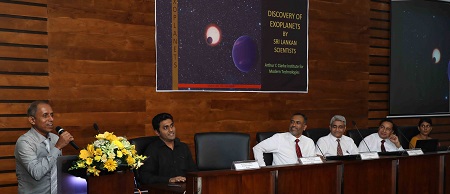For the first time in the island’s history, a group of Sri Lankans has discovered a new extra-solar planetary system (Exoplanets). The team was headed by Mahesh Herath (27), a research scientist at the Astronomy division of the Arthur C. Clarke Institute for Modern Technologies (ACCIMT) with Saraj Gunesekera, principle research scientist, ACCIMT.
By Yomal Senarath Yapa
For the first time in the island’s history, a group of Sri Lankans have discovered a new extra-solar planetary system (Exoplanets). The team was headed by Mahesh Herath (27), research scientist at the Astronomy division of the Arthur C. Clarke Institute for Modern Technologies (ACCIMT) with Saraj Gunesekera, principle research scientist, ACCIMT.
Of the two Mr. Herath is working under the guidance of Professor Chandana Jayaratne of the University of Colombo to complete his MPhil degree.
The exoplanets were discovered using data obtained by the NASA Kepler/K2 mission, which is a spacecraft with a powerful optical telescope. These two planets orbit the star designated as EPIC 212737443.
The smaller of the two planets, named K2-310b, has a radius of 16,500 Km (2.6 times the radius of the Earth) with an equilibrium temperature of 263 degrees centigrade, while the larger second planet, named K2-310c, has a radius of 17,220 Km (2.7 times the radius of the Earth) with an equilibrium temperature of 42 degrees centigrade.
The sizes of the planets strongly imply that they have atmospheres thicker and larger than that of our Earth, likely composed of elements such as Hydrogen, Helium and perhaps water vapour and Ammonia. There is uncertainty whether these planets are rocky or gaseous due to their existence in a size range that hovers between the generally accepted sizes for both rocky planets and gaseous planets.
With this discovery, Sri Lanka joins a select group of nations with institutions from which exoplanets were discovered, including United States, Canada, Western, Northern and Central European nations, Australia, Japan and China.
The results of this research venture were published in the prestigious Monthly Notices of the Royal Astronomical Society (MNRAS), and added to the NASA exoplanet archive as well as the Exoplanet Encyclopaedia.
Pictured below from left :
Mr. Saraj Gunasekara. Acting Director of Space Technology and Application, Arthur C Clarke Institute for Modern Technologies (ACCIMT) speaks to the media.
Mr. Mahesh Herath. Research Scientist, Arthur C Clarke Institute for Modern Technologies (ACCIMT)
Eng Sanath Panawennage. Director-General and CEO Arthur C Clarke Institute for Modern Technologies (ACCIMT)
Prof. Upul Sonnandara. Chairman Board of Governors Arthur C Clarke Institute for Modern Technologies (ACCIMT)
Prof. Chandana Jayarathne. Member Board of Governors Arthur C Clarke Institute for Modern Technologies (ACCIMT)
Eng. Mrs. Kumari Ediriweera. Deputy Director-General Technical / Operation Arthur C Clarke Institute for Modern Technologies (ACCIMT)
(Pic by M.A. Pushpa Kumara)

Leave Comments